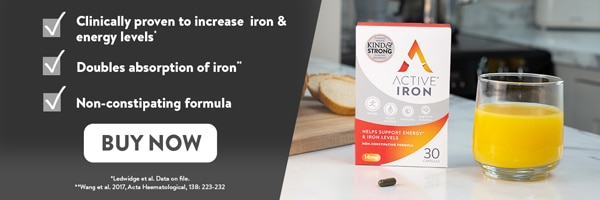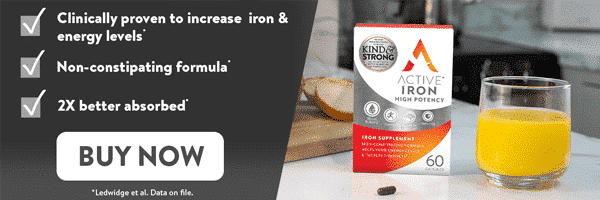Only a fraction of ingested iron is absorbed by the body. The amount may range from only 5% to 35%, according to a journal in the National Centre for Biotechnology Information, which means that even if you’re consuming ample iron, chances are you’re not absorbing all of it.
How Does Your Body Absorb Iron?
The amount of iron absorbed can depend on the type of iron being consumed, as well as the circumstances surrounding when and how the iron is ingested. Here, we’ve looked at some of the different types of iron and how they are absorbed.
Iron Absorption Site
Ferrous iron Absorption
Ferrous iron is quickly oxidized to the insoluble ferric (Fe+3) form at the human body’s pH.
When Fe+3 enters the first section of the small intestine, gastric acid lowers the pH allowing the transport of Fe+2 across the intestinal absorptive cells.
This lowering of the pH by gastric acid, which in turn allows the transport of Fe+2, is called ferric reductases. This process “enhances the solubility and uptake of ferric iron”, according to the Review on iron and its importance for human health.
However, if gastric acid production is impaired, iron absorption will be reduced substantially.

Haem Iron Absorption
Dietary haem is also transported across the intestinal absorptive cells; the process that allows this is unknown.
Following this yet unknown process, dietary haem is metabolized by haem oxygenase 1 (HO-1) to free (Fe+2) for absorption.
This process is more efficient than the absorption of inorganic iron, according to the Review on iron and its importance for human health. This process also does not depend on gastric acid for absorption.
Red meats that are high in haemoglobin are known to be excellent nutrient sources of iron. They provide Fe+2 directly, which can be transported across the intestinal absorptive cells and then exported to the bloodstream through the Fe+2 transporter ferroportin.
The flow of Fe+2 is sped up by several other mechanisms until it is picked up by transferrin, which delivers it into tissues.
The Review on iron and its importance for human health states that this process can be carried out up to 10 times daily in an attempt to deliver the iron that the body needs. The total iron content of transferrin corresponds to less than 0.1% of body iron.

Non-haem Iron Absorption
Another process is thought to exist for the absorption of plant ferritins which are mostly present in legumes. However, most ferritin appears to be degraded during digestion.
How long does it take for iron to be absorbed?
How long it takes for iron to be absorbed is largely dependent on when and how you take it, as well as the form of iron you are taking, and the other foods that you are consuming.
As described above, haem and non-haem iron are broken down by the body differently. Haem iron present in meat, fish and poultry (MFP) can enhance your absorption of non-haem iron. Vitamin C rich foods such as oranges, bell peppers, and lemons and supplemental vitamin C can aid iron absorption.
Absorption of iron can also be reduced by the other foods that you consume. For example, one boiled egg can reduce the absorption of iron in a meal by as much as 28%. This ‘egg factor’ is caused by the phosphoprotein in eggs, a compound with an iron-binding capacity that can impair iron absorption. Consider having your eggs away from iron-rich meals or as a standalone snack. [ Gordon and Chow 1984; Insel et al 2004; Ishikawa et al 2007]
Tea, coffee, milk, eggs, wholegrain cereals, and dietary fibre can also reduce iron absorption. These foods can also affect your body’s ability to absorb iron from your iron supplement.
Calcium and Iron Absorption
Calcium in food can bind to iron and reduce its absorption. [https://pubmed.ncbi.nlm.nih.gov/21462112/] However the effect on absorption is temporary, so if you do want to drink milk, just wait 2-3 hours before taking your iron supplement. Milk alternatives that do not contain calcium can be taken with your iron supplement.
It is generally best to take your iron supplement 30 – 60 mins before food or in-between meals. This includes tea, coffee, dairy products, as well.
Vitamin C and Iron Absorption
Vitamin C enhances the absorption of iron, and it is often recommended that iron supplements be taken with a glass of orange juice or with water containing a squeeze of lemon. However, the dose required to improve absorption is quite large (250-500mg). While many supplements will contain vitamin C in ascorbic acid form, they may not contain enough to enhance absorption and so a supplement may be required.
Active Iron has been clinically proven to ensure better absorption of iron, so there is no need to use an ‘enhancer’ like Vitamin C to boost absorption further. However, there is no issue if you wish to take Active Iron with a vitamin C supplement or a glass of orange juice.
Ref: https://www.ncbi.nlm.nih.gov/pubmed/2507689
Iron absorption is enhanced by:
• Taking iron at the best time for your body
• Haem iron (found in meat, poultry and fish)
• Vitamin C (orange juice, supplemental vitamin C)
• Taking an iron supplement that targets the natural site of iron absorption rather than releasing fully in your stomach
How To Take Iron Supplements For Best Absorption
If you want to take iron supplements for best absorption, the answer is simple: take an Active Iron tablet, and carry on with your day! Active Iron was developed by scientists at Trinity College Dublin, using a new technology harnessing a ground-breaking iron-whey protein complex which ensures that iron is released in the small intestine, where it is most readily absorbed.
The unique whey protein in Active Iron ensures that the tablets are not dissolved in the stomach, where oxidisation triggers unpleasant gastrointestinal side effects.
Studies confirm that the new Active Iron formulation increases iron levels by 94% while being so gentle that it can be taken on an empty stomach. In our trial, 9 out of 10 experienced no side effects whatsoever. Active Iron only uses denatured whey-protein and encapsulated ferrous sulfate.
* Wang et al. 2017, Acta Haematological, 138: 223-232



